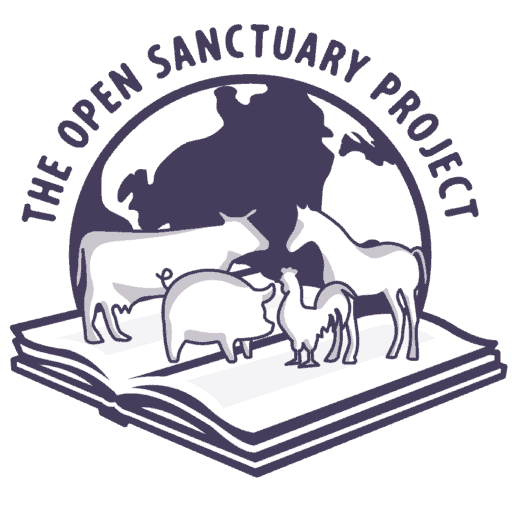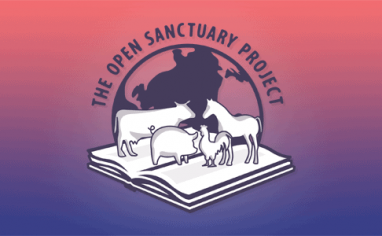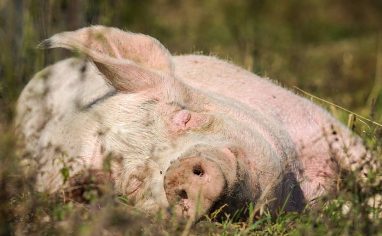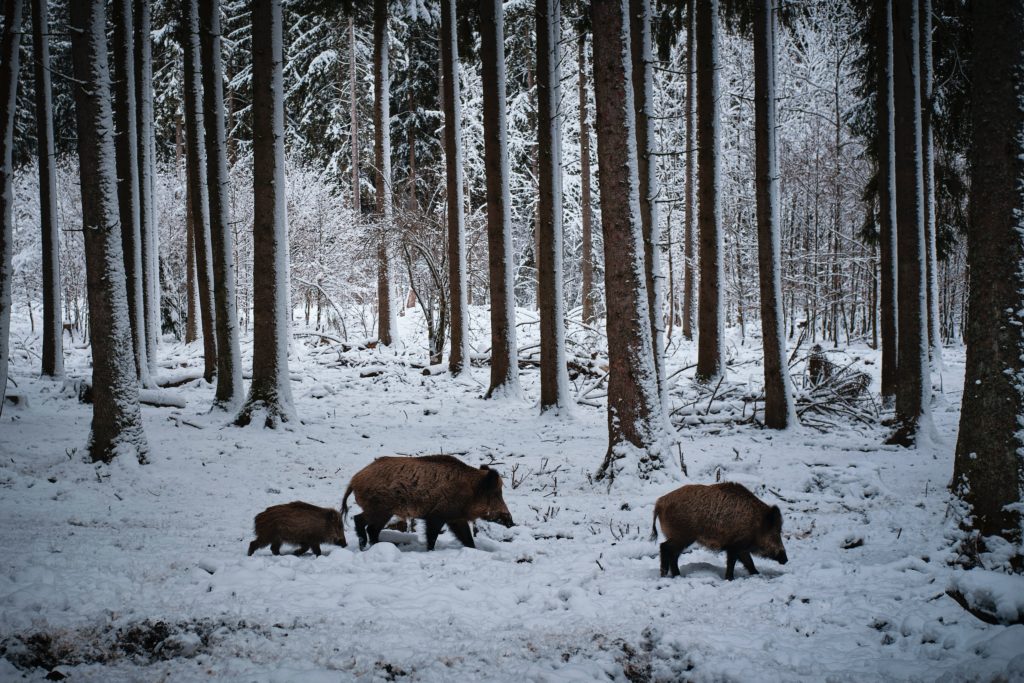
This resource has been fully reviewed and updatedA member of The Open Sanctuary Project’s staff has given this resource a full review and provided updates where necessary. by a member of The Open Sanctuary Project as of October 1, 2025. It was originally published on December 19, 2022.
Where Do Pigs Come From? A Not So Boar-ing History
Pigs belong to the scientific genus known as Suidae, a group of hoofed mammals commonly referred to as pigs, hogs, or boars, who appeared on Earth sometime between 20 and 35 million years ago! Depending on the source, it’s believed there are between 14 and 19 distinct species of suids that exist today. One of those is the wild boar (Sus scrofa), who is the living wild ancestor of the modern domesticatedAdapted over time (as by selective breeding) from a wild or natural state to life in close association with and to the benefit of humans pig (Sus scrofa domesticus). Though wild boars likely originated in Southeast Asia and subsequently spread throughout Eurasia and North Africa, they were forcibly bred and introduced to nearly every part of the world except Antarctica.
Like domesticated pigs, wild boars are socially complex beings who usually prefer to live in environments with lots of shrubbery, trees, tall grass, and easy access to water. However, they can live and thrive in a vast array of habitats ranging from tropical islands to boreal taigas, grasslands, mountainous regions, and even deserts! They typically live in matriarchal families known as sounders, which consist of several interrelated females, their babies, and occasionally a few males. With the exception of mating season and the occasional safety check-in, fully grown males usually prefer to live alone.
Wild boars are most active at night, and spend a great deal of their time foraging for foods like fruits, nuts, grasses, roots, bulbs, and grubs underground. They regularly take baths in muddy wallows to cool off and find refuge from irritating insects. They also communicate with one another frequently through a range of call types, including grunts, snorts, snarls, and squeals. During the day, wild boars like to rest in sheltered areas and communal nests that are sometimes occupied by whole families. They can live up to 20 years old!
Pig Domestication: A Series of Un-porcine-ite Events
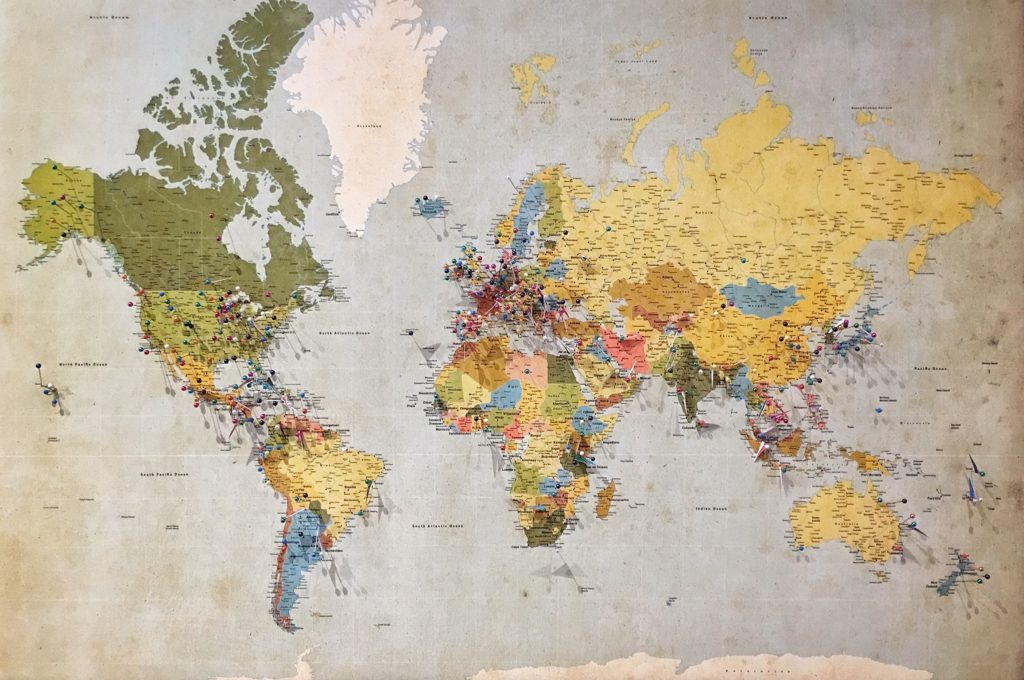
Researchers believe wild boars became domesticated by humans in at least three separate historical events. The first event took place in Central Asia near the Tigris Basin in what is now known as Turkey sometime between 10,000 and 15,000 years ago. A second domestication event occurred in China about 8,000 years ago. Then, sometime around 6,500 years ago, the farmers from the Tigris Basin migrated with the pigs they had domesticated to Northern Europe, where they subsequently interbred them with local European wild boars. This resulted in a third unique domestication event and the development of the European domesticated pig. In all three events, pigs were domesticated and used primarily as a source of food. Over the course of thousands of years, various cultures continued to selectively breed and spread them all over the world via migration, trade, and colonization.
Despite having originated in Central Asia, domesticated pig populations declined in this area sometime around 1,000 B.C.E. primarily as a result of religious restrictions on eating them. In Europe, however, exploitationExploitation is characterized by the abuse of a position of physical, psychological, emotional, social, or economic vulnerability to obtain agreement from someone (e.g., humans and nonhuman animals) or something (e.g, land and water) that is unable to reasonably refuse an offer or demand. It is also characterized by excessive self gain at the expense of something or someone else’s labor, well-being, and/or existence. and consumption of domesticated pigs vastly increased. Between the years 1400 and 1700, massive colonization efforts led by people like Christopher Columbus, Hernando De Soto, Hernán Cortés, and Sir Walter Raleigh forcibly introduced European domesticated pigs to almost all areas of the Americas as a source of food. By the early 1800s, animal exploitation had industrialized in many parts of the world, and selective breeding of pigs and many other farmed animalsA species or specific breed of animal that is raised by humans for the use of their bodies or what comes from their bodies. skyrocketed. Large stockyards, slaughterhouses, and packing facilities became centrally located in major cities, and innovations in transportation, like refrigerated train cars, made it easier and faster to transport animal flesh over wider geographic areas.
Sadly, domesticated pigs are one of the most commonly exploited animals in the world today. Currently, there are over 300 different domesticated pig breeds, each selectively bred by humans for different human desires and specific attributes. While most have been bred to grow dramatically larger than their wild ancestors for human consumption, other breeds have been bred to remain smaller to be used as “petsAnimals who spend regular time with humans in their home and life for companionship or human pleasure. Typically a small subset of animal species are considered to be pets by the general public.” and victims of biomedical research. When it comes to caring for pigs, it is imperative that sanctuaries consider these aspects of their current existence as well as all of the other potential effects breed-specific domestication and farming have had on them so that they can provide them with the most appropriate healthcare, diet, living space, and enrichment.
Pigs Raised for Their Flesh
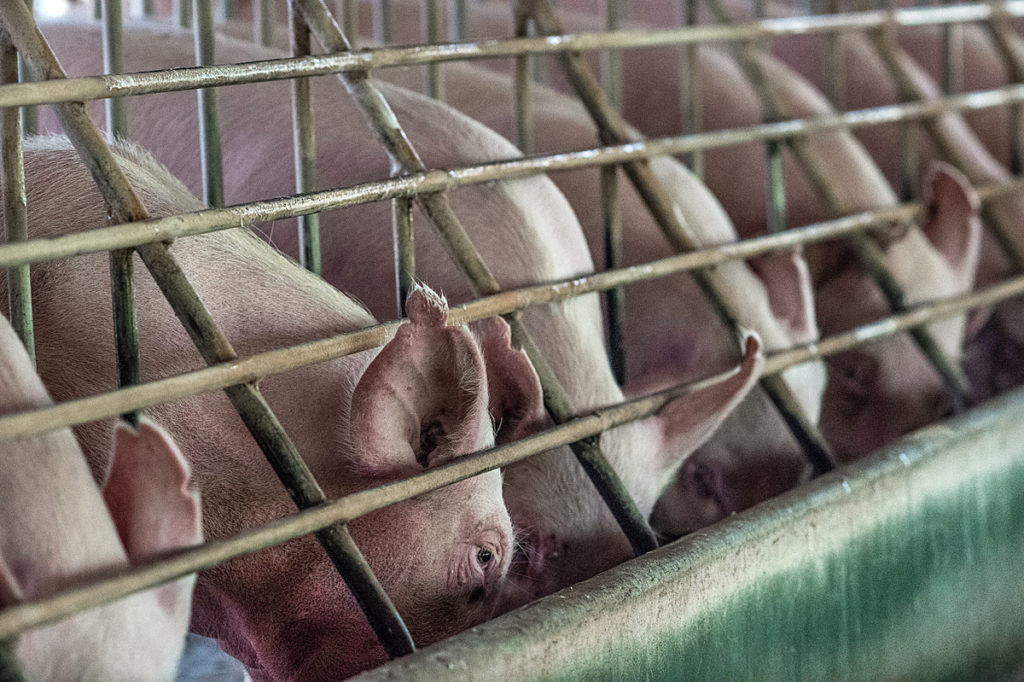
Pigs are farmed primarily for the consumption of their flesh, called “pork”, but also for their bones, hide, and bristles to make things like paint brushes, footballs, gauze, and bone china. According to Faunalytics, over 1.5 billion pigs were slaughtered globally in 2023. At The Open Sanctuary Project, we use the term “large breedDomesticated animal breeds that have been selectively bred by humans to grow as large as possible, as quickly as possible, to the detriment of their health. pig” to refer to domesticated pig breeds that have been selectively bred by humans to grow significantly larger than their wild ancestors and who are most often raised for their flesh in commercial agricultural settings and hobby farmsFor-profit organizations focused on the production and sale of plant and/or animal products.. Because these breeds are typically farmed, they are often referred to as “farm pigs” to distinguish them from mini or “petAn animal who spends regular time with humans in their home and life for companionship or human pleasure. Typically a small subset of animal species are considered to be pets by the general public.” pigs. Other terms used to describe large breed pigs include “hogs” and “swine.” Within the category of large breed pigs, we include breeds that are sometimes referred to as “commercial pigs” as well as breeds that are referred to as “pastured breeds” and “heritage breeds.” While we do not believe that individuals should be defined by the way they are exploited, it’s important that folks understand what these terms mean.
In the U.S., Sentient Institute estimates that 98.6% of pigs are raised in large-scale pig operations (also known as factory farmsIntensive agricultural operations that prioritize large volume animal product production using strict production methods, typically away from the public eye.) – giant warehouses where pigs spend their shortened lives on concrete or slatted floors with thousands of other pigs. Pigs bred to be exploited in this way are often referred to as “commercial” pigs and are the most commonly exploited pigs in the world. Large-scale pig farming operations often have breeding programs where they “create” a specific crossbreed to meet consumer demand and maximize profits. Breeds commonly used in commercial breeding programs include, but are not limited to, the Duroc, Landrace, and Yorkshire.
Modern operations that raise “commercial” pigs have been able to exert unfathomable control over their bodies and behaviors through a myriad of cruel practices in order to maximize profit. Corporate success is measured by how many pigs they can breed and how fast they can make them grow in extremely confined indoor settings. Unfortunately, this has come at the cost of the pigs’ well-being, leaving them to suffer miserably throughout their shortened lives. Though they are cognitively and behaviorally very similar to wild boars – highly social, emotional, and intelligent animals who spend most of their lives exploring and rooting in the soil with their families – pigs raised in these settings are prohibited from expressing their natural instincts and desires. This puts enormous stress on them, both internally and externally, leading to serious mental illness, trauma-related injuries, disease, and premature death.
Pigs raised for their flesh in these settings are killed when they reach “market weight,” which is typically when they are between 5 and 6 months of age. Female pigs exploited for their breeding capabilities are impregnated when they are around 7 months old and are kept in extreme confinement. The remainder of their life is a constant cycle of pregnancy, birth, and nursing their young until they, too, are sent to slaughter.
Like “commercial” pig breeds, “pastured breeds” have been selectively bred for their flesh, but, as the term suggests, “pastured breeds” are typically raised in outdoor commercial agricultural settings rather than being confined indoors. As with factory farms, outdoor operations often use crossbreeding in order to raise pigs that have specific attributes. While there is variation in size between different breeds, “pastured breeds” typically grow at a slower rate than pigs raised in large-scale, indoor pig operations, taking one to two months longer to reach “market weight.” Examples of “pastured breeds” include the Berkshire, Chester White, Hampshire, Mangalista, and Kunekune, as well as various crosses (including crosses with heritage breeds, defined below).
Within the category of “pastured breeds” are “heritage” breeds. In modern agricultural terms, “heritage” pigs are defined as pig breeds that are or have been endangered (according to the LivestockAnother term for farmed animals; different regions of the world specify different species of farmed animals as “livestock”. Conservancy), have a long history in the U.S. (meeting specific criteria set by the Livestock Conservancy), and are registered as “purebred.” Heritage breeds include the Tamworth, Red Wattlea fleshy pendulous process usually about the head or neck (as of a bird), Large Black, and Gloucestershire Old Spot. Some heritage breeds are closer in size to their wild ancestors (ex., Meishan, Mulefoot, and Ossabaw Island, which are also among the mini pigThe term “mini pig” is used to categorize smaller breeds of pigs, such as Potbellies, Julianas, and Kunekunes, and to differentiate between these breeds and large breed pigs, such as Yorkshires, Landrace, or Hampshires, who are sometimes referred to as “farm pigs”. The descriptor “mini” can be a bit misleading- some breeds of mini pigs can weigh over 200 pounds! Terms like “teacup”, “micro”, “pocket”, “nano”, and “micro mini” are deceptive terms that are sometimes used to intentionally mislead people into thinking an individual pig will remain a certain size. breeds recognized by the American Mini Pig Association). Others are similar in size to larger breeds.
Heritage pig breeds are sometimes referred to as “old-world breeds” because they are similar to the pigs raised a century ago. Consumer desires have changed since this time, and a major difference between heritage pig breeds and other large breed pigs is that heritage breeds typically have less muscle and more fat than breeds that have been selectively bred to meet the demand for leaner flesh. Compared to other pasture-raised breeds, heritage breeds typically grow more slowly and are, therefore, killed at an older age than other breeds in agricultural settings. That said, all pigs raised for their flesh are allowed to live only a small fraction of their natural lifespan (which varies based on many factors, but can exceed 10 years).
While people who are focused on exploitation may need to distinguish between the categories listed above, from a sanctuary care perspective, this distinction is not usually necessary. We’ll talk more about care at the end of this resource.
Pigs Exploited For Research
Pigs have been exploited in research for centuries and are used in many different research areas. Though large breed pigs have been and are used in research, their large size and rapid growth rate (viewed as positive attributes by those who exploit their bodies for food) are often viewed as less than ideal. In the 1950s, miniature pigs were developed, and their smaller size made them preferable to large breed pigs because they were easier to house and work with in a lab setting. Because they share many similarities with humans when it comes to things like anatomy, physiology, and immunology, pigs are often used in biomedical research. According to the National Anti-Vivisection Society (NAVS), pigs are used as test subjects for surgical techniques, in transplantation studies, and in toxicology and pharmacology studies, as well as in other areas of medical research.
While their similarities to humans are often touted as the reason for their use in biomedical research, it’s important to also recognize that this is not the only reason they are so widely used. Most people do not have an emotional attachment to pigs and rats, and therefore, these species have become more and more popular in research, and their use is generally viewed as more acceptable by the public. As a result of the way pigs are viewed, NAVS suspects that the number of pigs exploited in research may very well increase “as they are viewed as an alternative to other non-rodent animals, including dogs, which the public identifies as companion animalsAnimals who spend regular time with humans in their home and life. Typically cats and dogs are considered companion animals, though many species of animals could also be companion animals., and nonhuman primates, who may be given greater consideration because they are more closely related to humans.”
Mini pig breeds commonly exploited in research include the Yucatan, Hanford, Sinclair, and Göttingen.
Pigs Exploited By The “Pet” Industry
A Note On “Pets”
Before we talk about “pet” pigs, we want to just remind folks that labeling someone as a “pet” or companion animalAn animal who spends regular time with humans in their home and life. Typically cats and dogs are considered companion animals, though many species of animals could also be companion animals. says more about how that particular pig is raised and viewed by their caregivers than it does about their genetics (the same is true when labeling a species or breed a “food animal”). Large breed pigs can also be cared for as companion animals, but when it comes to the “pet” industry, it is the mini pig breeds that are bred and sold as “pets.” Therefore, these breeds will be our focus in the next section.
In addition to being exploited in research, some of the smallest pig breeds are commodified as “pets.” The term “mini pig” or “miniature pig” (sometimes used interchangeably with the term “potbelly pig”) is widely used to describe these smaller breeds. It’s important to recognize that the descriptive term “mini” is relative and is intended to differentiate smaller pig breeds from large breed pigs. An individual’s weight will vary depending on their genetics and diet, but typically ranges from 75 to 200 pounds. This is significantly smaller than the size of a mature large breed pig, but not exactly small compared to other species commonly viewed as “pets.” Though not all mini pigsThe term “mini pig” is used to categorize smaller breeds of pigs, such as Potbellies, Julianas, and Kunekunes, and to differentiate between these breeds and large breed pigs, such as Yorkshires, Landrace, or Hampshires, who are sometimes referred to as “farm pigs”. The descriptor “mini” can be a bit misleading- some breeds of mini pigs can weigh over 200 pounds! Terms like “teacup”, “micro”, “pocket”, “nano”, and “micro mini” are deceptive terms that are sometimes used to intentionally mislead people into thinking an individual pig will remain a certain size. are raised as “pets” (for example, those exploited for use in biomedical research), in many circles, the term “mini pig” is synonymous with “pet pig” and is used to distinguish them from pigs viewed as “food animals.”
The idea of pigs as pets can be traced back to the mid-1980s when the Vietnamese Potbelly pig was first brought to North America, initially with the intention of being used in zoosOrganizations where animals, either rescued, bought, borrowed, or bred, are kept, typically for the benefit of human visitor interest.. However, these pigs caught the attention of private buyers, and it wasn’t long before celebrities were seen with piglets on the red carpet, and the fad of “owning” a mini pig took off. Since that time, the popularity of mini pigs as pets has waxed and waned, but a common theme is that these individuals are often seen as a novelty, and many folks put themselves in the role of pig caregiverSomeone who provides daily care, specifically for animal residents at an animal sanctuary, shelter, or rescue. without an accurate and thorough understanding of what pigs need. Sometimes this is the result of a lack of due diligence on the guardian’s part, perhaps making assumptions about what “mini” means. Other times, folks are conned into believing these pigs will remain impossibly small by deceitful breeders. Terms like “teacup”, “micro”, “pocket”, “nano”, and “micro mini” are deceptive labels used to make people think a pig will remain piglet-sized. In addition to these marketing tactics, some breeders will employ harmful and deceitful practices to further the lie that these pigs will stay tiny, for example, claiming that a piglet is full-grown or deliberately feeding a diet that will leave the individual so malnourished that their growth is stunted. People who take on the care of these individuals, thinking they are going to remain small, are often shocked to watch them grow to their actual size and, consequently, are either unable or unwilling to continue to care for them.
Whether it is from a lack of information or misinformation, many pig guardians end up needing or wanting to rehomeThe act of giving an animal a new home, typically because the previous guardian cannot or will not continue to provide adequate care. their companions. Shelters and sanctuaries are often inundated with requests to take former “pet pigs,” and some pigs who are in need of a new home end up abandoned. It’s not uncommon for unwanted pigs to be offered up for free to anyone who wants them. This often leads to further exploitation and outright cruelty. According to American Mini Pig Rescue Advocates, former pet pigs may then be used as breeders, for hunting practice, for use in dog fights, or they may be killed for their flesh.
Breeds used in the pet industry include the Vietnamese Potbelly and Juliana, as well as medium-sized breeds such as the Kunekune and Meishan. There have also been instances of breeds more often used in biomedical research (the Göttingen, Panepinto, and Yucatan) being commodified as pets or otherwise making their way into homes as companion animals. Like large breed pigs, many “pet” pigs are a mix of breeds.
Feral/Wild Pigs
As mentioned above, European colonization of the Americas brought with it the introduction of European domesticated pigs. Brought along on expeditions as a food source, domesticated pigs were often left behind either intentionally (so there would be a source of food for the return journey) or accidentally due to escape. Thus was the beginning of the feral pig population in the Americas (and other parts of the world).
In the late 1890s, wild Eurasian boars started being brought to the US to create a new “big game” opportunity for wealthy sport hunters. As with the domesticated pigs who came before them, some escaped and others were intentionally released. These wild boars then bred with feral pigs, creating hybrids. Today, free-living pigs in the US may be referred to as “feral” or “wild” pigs/swine/hogs/boars, etc., but in reality, this group is composed of both feral pigs, wild Eurasian boars, and hybrids from interbreeding between these two groups.
Up until the late 1980s, feral pig populations in the US were found primarily in southern and West Coast states. However, between 1989 and today, the number of states that report having feral pig populations has more than doubled. Like the introduction of pigs to the US, the expansion of states reporting feral pigs can be traced to human activity. In many cases, the sudden presence of feral pigs in new areas is the result of pigs escaping from privately owned hunting preserves or the intentional (and illegal) translocation of feral or wild pigs.
Despite the role humans played in the introduction and continued expansion of feral pig populations, the pigs themselves are vilified. This is not an issue unique to the US. In many parts of the world, feral pigs are considered “pests” and their extermination is not only encouraged, but coordinated and funded by the government.
Laws and Regulations Concerning Feral Pigs
Regulations and restrictions concerning the housing of feral pigs vary by state and local law, and may limit whether or not your sanctuary can legally care for them. It’s important to consult knowledgeable local legal counsel so that you can clearly understand your state and local laws around this and make sure you are carefully considering and meeting all requirements.
The Importance of Sanctuary: Time to Re-root
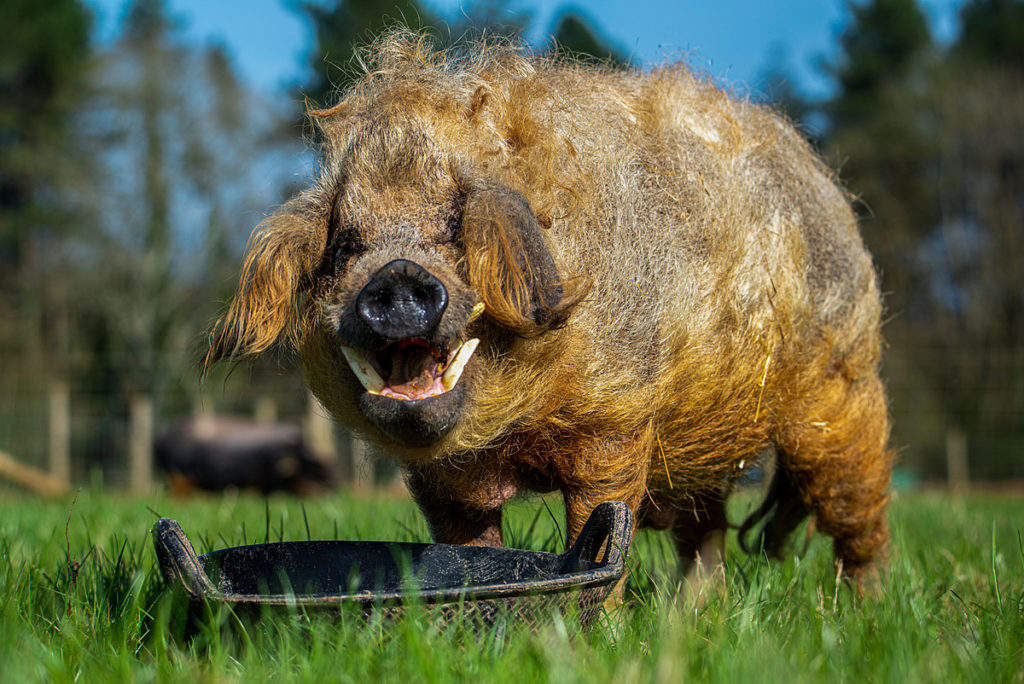
In some areas of the world, the number of pigs exploited and killed for their flesh is slowly decreasing, while in other areas, it’s rapidly increasing. In addition to being exploited for their flesh, pigs continue to be victims of research and to be bred and sold as novelty pets. All this leaves us with the important task of understanding why these things are happening and how we can advocate on pigs’ behalf. One way we can do this is by learning more and teaching others about pigs through compassionate educational resources like sanctuaries for farmed animals, books, videos, and articles like this. Another way we can do this is by modeling an alternative way of being in relationship with pigs that honors them as individuals deserving of a life free from harmThe infliction of mental, emotional, and/or physical pain, suffering, or loss. Harm can occur intentionally or unintentionally and directly or indirectly. Someone can intentionally cause direct harm (e.g., punitively cutting a sheep's skin while shearing them) or unintentionally cause direct harm (e.g., your hand slips while shearing a sheep, causing an accidental wound on their skin). Likewise, someone can intentionally cause indirect harm (e.g., selling socks made from a sanctuary resident's wool and encouraging folks who purchase them to buy more products made from the wool of farmed sheep) or unintentionally cause indirect harm (e.g., selling socks made from a sanctuary resident's wool, which inadvertently perpetuates the idea that it is ok to commodify sheep for their wool). and exploitation. Animal sanctuaries can play a critical role in this endeavor by caring for pigs in a way that carefully considers the complexities of their current existence. While they are physically, cognitively, and behaviorally very similar to their wild boar relatives in many ways, domestication and modern farming have had a significant impact on their physical and mental well-being.
Due to the ways in which they have been bred, both large breed pigs and mini pigs (particularly potbellied pigs) are prone to obesity and obesity-related health issues and require a carefully managed diet to ensure they get the nutrients they need while remaining at a healthy weight. While this is true for all pigs, regardless of breed, this is an area where it’s important to know if the individual you are caring for is a large or mini breed, as mini breeds will require smaller portions. You can read more about providing a healthy diet for pigs here.
Whereas wild pigs naturally wear down their hooves through regular activity, domesticated pigs require routine hoof care to avoid serious and potentially debilitating foot issues. You can read more about hoof care for pigs here. Another important aspect of domesticated pig care pertains to their reproductive health. While all male mammalian farmed animal sanctuaryAn animal sanctuary that primarily cares for rescued animals that were farmed by humans. residents should be neutered to prevent breeding, it’s important to recognize that female pigs also need to be spayed because they face a significant risk of reproductive disease. You can read more about spaying and neutering pigs here. Domesticated pig breeds that have been bred to have lighter skin rather than the naturally dark skin of their ancestors are prone to sunburns and subsequent non-melanoma skin cancer unless they are provided with appropriate sun protection.
To read more about the general care pigs require, check out our Introduction To Pig Care here!
The important impacts of pig ancestry and domestication are both essential to consider when it comes to providing sanctuary for pig residents. Their similarities to their wild boar ancestors require that we keep their natural instincts and preferences in mind when it comes to providing them with appropriate living spaces, foraging opportunities, enrichment, etc. However, it’s also important to understand the ways in which they have been affected by domestication and selective breeding and what we can do as caregivers to alleviate those negative impacts as much as possible. When it comes to providing sanctuary for pigs, striking an appropriate balance is critical, and understanding both their origins and how they diverge from their ancestors is an important step in achieving this.
SOURCES:
Additional Care Recommendations for Older Pigs | The Open Sanctuary Project
Creating a Good Home for Pigs | The Open Sanctuary Project
Creating an Enriching Life for Pigs | The Open Sanctuary Project
Daily Diets, Treats, and Supplements for Pigs | The Open Sanctuary Project
Daily Observation for Pig Health and Well-Being | The Open Sanctuary Project
Domesticated, Feral, or Wild: What’s the Difference? | The Open Sanctuary Project
Hoof Care for Pigs | The Open Sanctuary Project
How to Safely Be Around a Pig | The Open Sanctuary Project
Pigs and Mud: Let Them Wallow! | The Open Sanctuary Project
Potbellied Pigs in Particular: Addressing Their Unique Needs
Potential Pig Health Challenges | The Open Sanctuary Project
Safe Cohabitation Considerations for Pigs | The Open Sanctuary Project
Spaying and Neutering Pigs: A Health Imperative | The Open Sanctuary Project
Techniques and Practices Necessary for Responsible Pig Care | The Open Sanctuary Project
The Importance of Sun Protection for Pigs | The Open Sanctuary Project
Are Mini Pigs Real? | Best Friends
Feral Pigs Find Home at Ellis County Sanctuary | Green Source DFW
Pigs Learning Guide | Our Kith + Kin
Pig/Pork: Archaeology, Zoology, and Edibility | Pía Spry-marqués
The Domestication of Pigs: Sus Scrofa’s Two Distinct Histories | K. Kris Hirst
Potbellied Pig Veterinary Medicine | Dr. Kristie Mozzachio
Global Animal Slaughter Statistics And Charts | Faunalytics
Once Popular As pets, Potbellied Pigs Are Now A National Problem | Ohio State News
A Decade of Pig Genome Sequencing: A Window on Pig Domestication and Evolution | Martien A. M. Groenen (Non-Compassionate Source)
Definition of Heritage Swine and Pork Products | The Livestock Conservancy (Non-Compassionate Source)
What Is A Micro-Mini Pig? | North American Pet Pig Association (Non-Compassionate Source)
Vietnamese Potbelly Pig | Oklahoma State University (Non-Compassionate Source)
Production Cycle Of Swine | Bruce Hoar, DVMDoctor of Veterinary Medicine, an academic degree awarded to veterinarians in many countries., MPVM, PhD John Angelos, MS, DVM, PhD, DACVIM (Non-Compassionate Source)
A Pig’s Heritage | HERLIFE Magazine (Non-Compassionate Source)
So You Want To Raise Hogs? | Penn State Extension (Non-Compassionate Source)
Definition Of Heritage Swine And Pork Products | Livestock Conservancy (Non-Compassionate Source)
Understanding Pork Yields | University Of Maine Cooperative Extension Publications (Non-Compassionate Source)
Miniature Pig Breeds | American Mini Pig Association (Non-Compassionate Source)
Pasture Pig Basics | Utah State University Small Farms Extension (Non-Compassionate Source)
The Fate Of The Abandoned Pig | American Mini Pig Rescue Advocates (Non-Compassionate Source)
Pigs As Laboratory Animals | Rozkot M., Václavková E., Bělková J. (Non-Compassionate Source)
Importance Of The Pig As A Human Biomedical Model | Science Translational Medicine (Non-Compassionate Source)
Introduction of Feral Hogs | Texas A&M AgriLife Extension (Non-Compassionate Source)
History Of Feral Hogs In The United States | Feral Hogs Extension (Non-Compassionate Source)
Feral Swine Population Distribution | USDAThe United States Department of Agriculture, a government department that oversees agriculture and farmed animals. APHIS (Non-Compassionate Source)
History Of Wild Pigs | Mississippi State University Extension (Non-Compassionate Source)
Non-Compassionate Source?
If a source includes the (Non-Compassionate Source) tag, it means that we do not endorse that particular source’s views about animals, even if some of their insights are valuable from a care perspective. See a more detailed explanation here.
Source Disclosure
This article sourced information and inspiration from Our Kith + Kin, a single-member LLC run by Andie Springirth. Andie Springirth is also the author of this resource and Community Education Specialist at The Open Sanctuary Project. While her work with Our Kith + Kin informs her work with The Open Sanctuary Project and vice versa, they are in no way officially affiliated with or officially endorsed by one another.
